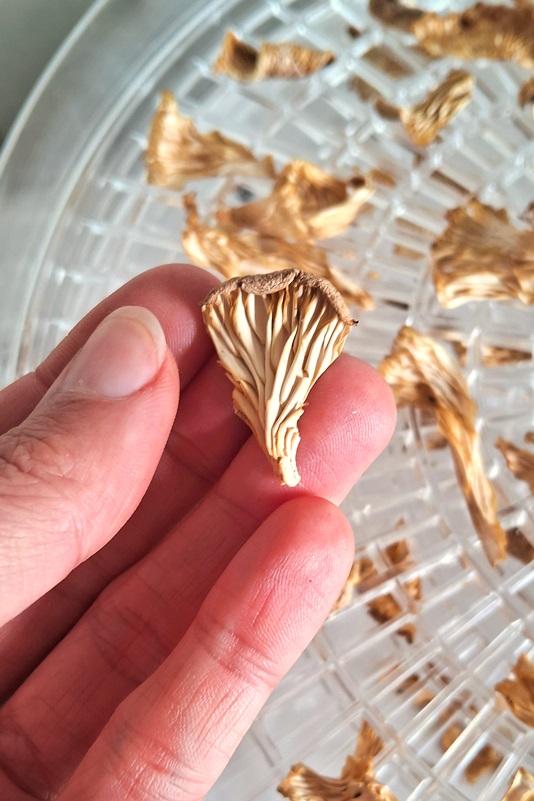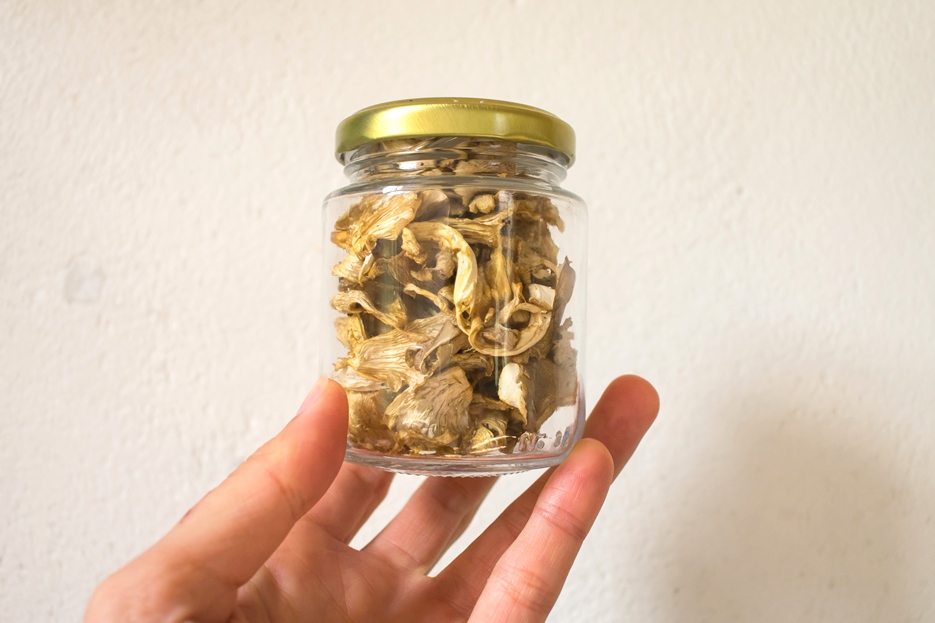The wild mushroom Pleurotus albidus is edible and can be found in abundance here all year round. The genus Pleurotus is popularly known as Oyster mushrooms and has many other edible species, like Pleurotus djamor.
The first time we came across this mushroom I thought it was from the genus Pleurotus but didn’t know the species. Researching on the Primavera Fungi book (A Fungi Guide from the South of Brazil), I thought it was Pleurotus albidus and later got confirmations on iNaturalist also.
A number of little insects, including ladybugs, love this mushroom. It’s common to see many on and around them, and also between the gills, which sometimes makes cleaning them quite annoying, lol.
How to identify the Pleurotus albidus mushroom



To identify this mushroom, you need to pay attention to its characteristics. They’re about 5 to 6 cm tall and 5 to 8 cm in diameter when mature. They’re white/cream in color, have a concave cap, and a very pronounced stipe (“stem”).
The hymenophore (the underside of the cap) has lamellae (gills) that are decurrent, they run from the underside to the stem without a clear separation. They grow on decaying wood – here it is very common to find them on fallen branches of Araucaria trees.
They like milder temperatures and plenty of humidity. Here in the Serra Gaúcha region we find them basically in all seasons, as these climate conditions can occur all year round. But most abundant I would say it’s in Autumn.
This species occurs from Mexico to Argentina, and is found in Brazil in the Atlantic Forest and Amazon biomes.
Pleurotus albidus is known to be used by traditional peoples of Mexico, Guatemala and Brazil – it’s one of the mushrooms consumed by the Yanomami (indigenous group from the Amazon), who eat it roasted in leaves. I found this and other information in an article by Mariana Drewinski on the website The Global Fungal Red List Initiative.
How to prepare the Pleurotus albidus mushroom



Thanks to all these valuable studies and experts, we were able to identify and try this mushroom, which we found to be very tasty – in addition to being super nutritious and having medicinal properties. I read in this scientific article that this mushroom has a high content of proteins, fibers, vitamins and a variety of minerals; and this article mentions its antioxidant and hypoglycemic effects.
To prepare it, first clean them using a small brush or toothbrush, or scrape them with a knife to remove dirt, insects and pieces of leaves that are stuck to them.
I recommend collecting them in the cleanest way possible, cutting the bottom part of the stem, removing the bulk of the dirt and not letting them fall to the forest floor to make this part easier, because when some dirt/soil gets into the gills it’s quite annoying to clean.
Then you can just do a basic preparation, sauté or stir-fry them in oil or butter with a little salt and black pepper for a few minutes (it will depend on the “doneness” you prefer, just taste and decide). I always use very little seasoning because I like to really taste the flavor of the mushroom, but you can add whatever seasoning you prefer.



If they are too moist, one tip is to sauté them in a frying pan without oil for a few minutes first and remove the excess water, and only then add the oil. They have a very interesting texture that remains firm, and it becomes similar to shredded chicken.
It has a mild but very tasty flavor. The first time we made it, we ate it with rice and a little sautéed broccoli, as shown in the photos above. Since then, we have found them countless times and have tried them in many different ways. Nowadays, I like to dehydrate them and always have a supply on hand to use in soups, risottos, and white sauce to eat with pasta.



And it is a privilege to still be able to do this, to find, pick and eat this edible and native wild mushroom, because in this article by Mariana Drewinski that I cited above she says that it is estimated that the population of this species will decrease by at least 12% in the next three generations, due to the increase in deforestation, caused by numerous reasons.
⚠ Remember to never eat wild mushrooms without proper identification.
📸 Pictures made in São Francisco de Paula, Rio Grande do Sul (Serra Gaúcha, South of Brazil).

